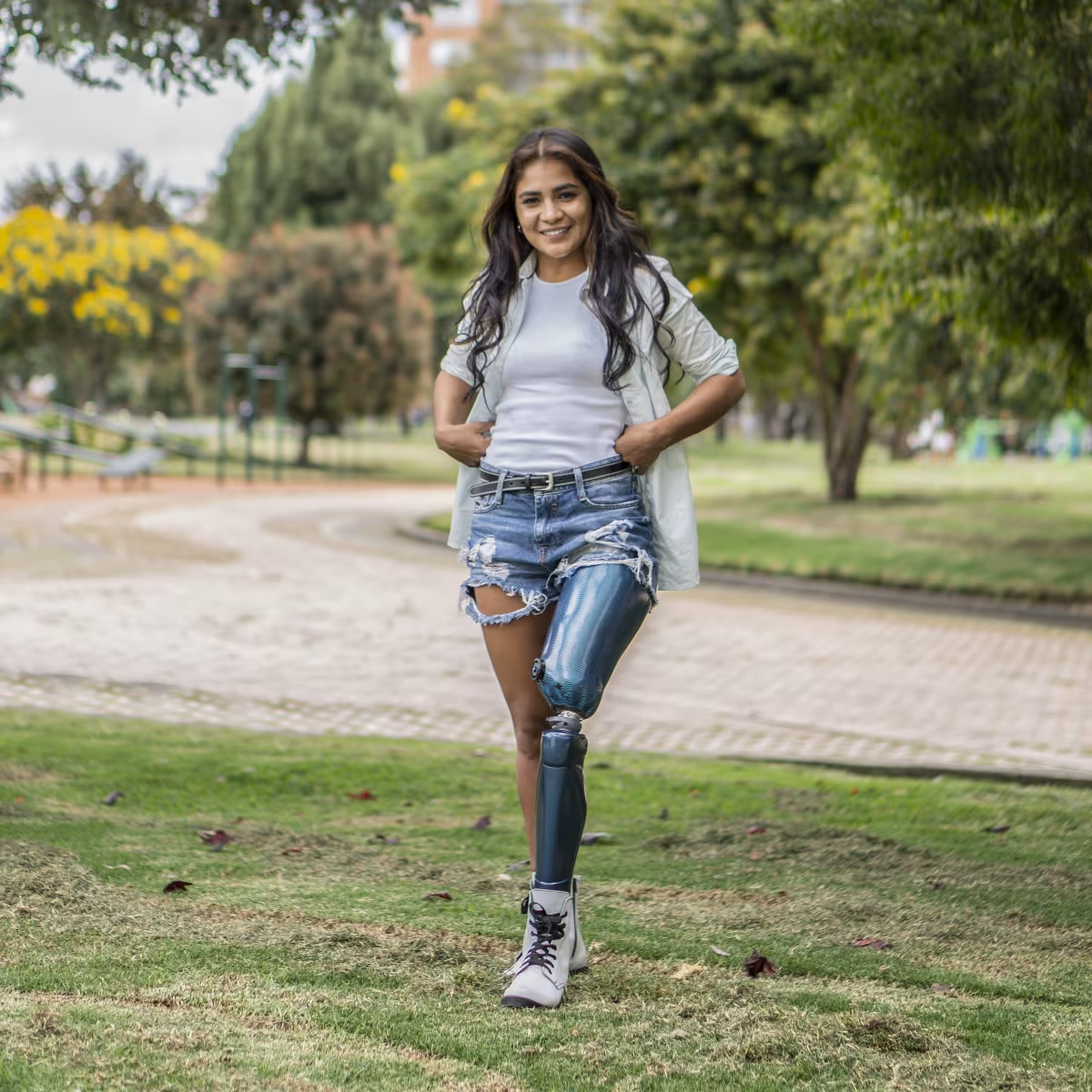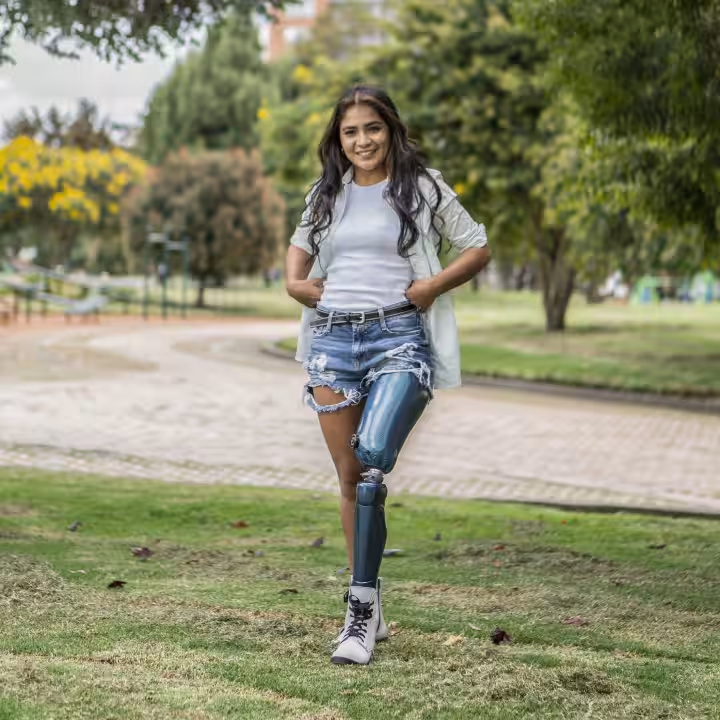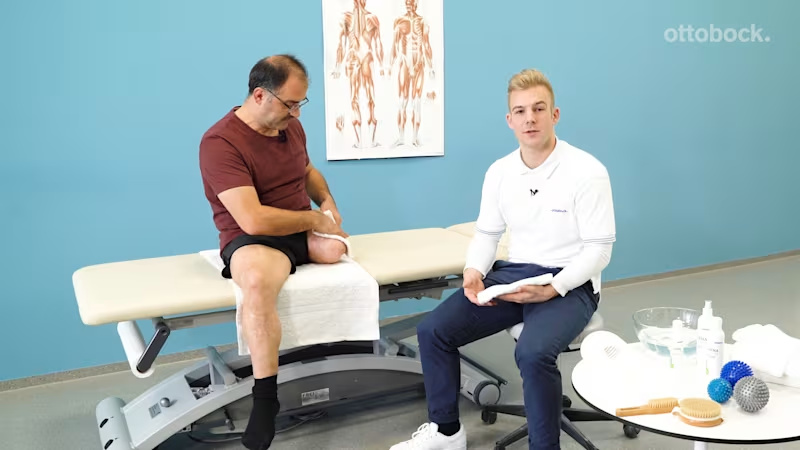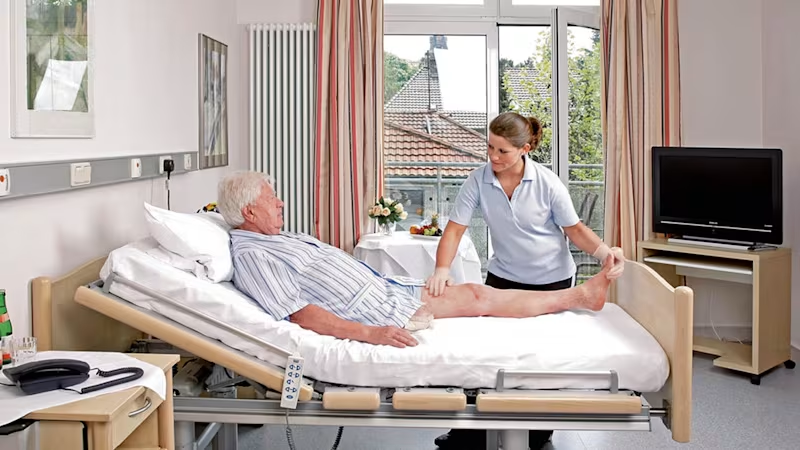


Rehabilitacija
Nakon amputacije, interdisciplinarni tim priprema vas za svakodnevni život s protezom – uključujući njegu bataljka, rukovanje i trening hoda s protezom.
Nakon amputacije, interdisciplinarni tim priprema vas za svakodnevni život s protezom – uključujući njegu bataljka, rukovanje i trening hoda s protezom.
Rehabilitacija nakon amputacije noge
Za početak, rana na bataljku mora pravilno zacijeliti. Kada proces zacjeljivanja završi nakon nekoliko tjedana, započinje faza rehabilitacije. Ona uobičajeno traje do pola godine.
Na temelju napretka vašeg oporavka, terapeutski tim odlučuje o tome kada možete započeti s intenzivnom rehabilitacijom. Za vrijeme faze rehabilitacije ciljano vas se priprema za nošenje proteze. Cilj je omogućiti vam maksimalnu mobilnost i samostalnost kako biste mogli u budućnosti voditi svoj život što je normalnije moguće. Međutim, vaše aktivno sudjelovanje je ključno za uspjeh rehabilitacije. Vaša motivacija i razina samopouzdanja mogu također dati važan doprinos.
Trening hoda s protezom za nogu
Cilj rehabilitacije je optimalno vas pripremiti za vaš život s protezom. To uključuje vraćanje snage, izdržljivosti i koordinacije kroz ciljanu fizioterapiju. Osim toga, poseban trening hoda uči vas kako koristiti samu protezu.
Osnovno funkcioniranje zgloba koljena također igra veliku ulogu u treningu hoda za transfemoralne amputirce. Iz tog razloga, program osposobljavanja i obrazovanja idealno će biti prilagođen protetskim komponentama koje koristite. Program bi trebao biti usmjeren na ponovno učenje svakodnevnih sekvenci pokreta i objašnjavanje funkcionalnosti vaše proteze.
Ovdje saznajte više o tome što uključuje trening hoda za osobe s amputacijom nogu.
Njega bataljka
Već tijekom faze rehabilitacije počinjete sami njegovati bataljak, ožiljak i zdravu nogu. Dok se u bolnici osoblje za skrb o bolesnicima i liječnici brinu za čišćenje rane i mijenjanje zavoja ili navlaka, vi se brinete za bataljak, ožiljak i za zdravu nogu tijekom faze rehabilitacije. Kontinuirana intenzivna skrb bit će ključna kako biste mogli nositi svoju protezu bez poteškoća.
Kako pravilno njegovati bataljak?
Vaš terapeut će vam pokazati kako pravilno njegovati bataljak. Kako biste spriječili da koža postane gruba i ljuskasta, ujutro i navečer perite bataljak vodom i blagim sapunom (npr. proizvodom Derma Clean). Nakon toga temeljito osušite kožu ili ju pažljivo obrišite tapkanjem i nanesite kremu. Derma Repair i Derma Prevent su dva Ottobock proizvoda iz linije proizvoda za njegu posebno razvijene za njegu kože koja je izložena jako nepogodnim utjecajima, kao što je koža na bataljku. Krema Derma Prevent, na primjer, pomaže pri sprječavanju nadraživanja kože tako što ju prekriva zaštitnim slojem koji ju čini mekanom i podatnom.
Ako su na bataljku nastali nabori kože ili kontrakture ožiljka, na njih je potrebno posebno pripaziti kako bi se spriječile infekcije. Vaš tim za rehabilitaciju može vas savjetovati o tome. Za vrijeme njege bataljka također obratite pažnju na ozljede kože, točke pod pritiskom i žuljeve, budući da oni zahtijevaju medicinski tretman. Zrcalo vam može pomoći pri pregledu stražnjeg dijela vašeg bataljka. Redovna masaža i lagano istezanje ožiljka je još jedan važan element u njezi bataljka.
Uzmite u obzir da je navlačenje proteze ujutro - odmah nakon pranja - često puno teže nego uobičajeno, budući da zbog tople vode koža na bataljku blago natekne.

Njega zdrave noge
Sve dok bataljak nije u mogućnosti nositi veliku težinu nakon amputacije, zdrava noga je izložena većem opterećenju.
Redovno pregledavajte i zdravu nogu, a pažnju obratite i na manje ozljede. Budući da čak i manje ozljede mogu postati opasne - posebno u slučaju infekcija - svaku ozljedu odmah treba liječiti liječnik, jer održavanje vaše zdrave noge funkcionalnom je neophodno. Također biste trebali redovno pažljivo rezati nokte na nogama. Mnogi pogođeni pojedinci posjećuje pedikera koji je za to prošao obuku.
Udobna cipela koja vam dobro odgovara također je dio procesa njegovanja vaše zdrave noge. Također se preporučuju i ulošci. Uz obuću, ključan je i izbor čarapa: one bi trebale biti izrađene od vune ili pamuka kako bi mogle dobro upijati znoj, a gornji dio čarape ne bi trebao biti prejako stegnut kako ne bi poremetio cirkulaciju krvi. Obične i duge čarape moraju pristajati uz nogu bez stvaranja nabora te ih treba nositi samo jedan dan. U suprotnom se znoj može nataložiti u obliku naslaga soli koje mogu nadražiti kožu i uzrokovati infekcije.
Također je važno da se ne prebacujete u invalidska kolica dok ste bosonogi, a ne biste trebali ni stajati niti hodati dok ste bosonogi jer je opasnost od ozljede prevelika. Dok ležite u krevetu, možete postaviti potporu s ispunom ispod pete i gležnja zdrave noge kako biste izbjegli stvaranje točaka pod pritiskom.
